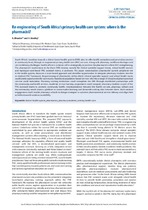| dc.contributor.author | Bheekie, Angeni | |
| dc.contributor.author | Bradley, Hazel A. | |
| dc.date.accessioned | 2018-05-14T09:29:32Z | |
| dc.date.available | 2018-05-14T09:29:32Z | |
| dc.date.issued | 2016 | |
| dc.identifier.citation | Bheekie, A. & Bradley, H. (2016). Re-engineering of South Africa’s primary health care system: where is the pharmacist? South African Family Practice, 58(6): 242–248 | en_US |
| dc.identifier.issn | 2078-6190 | |
| dc.identifier.uri | http://dx.doi.org/10.1080/20786190.2016.1186365 | |
| dc.identifier.uri | http://hdl.handle.net/10566/3656 | |
| dc.description.abstract | South Africa’s transition towards a district-based health system (DHS) aims to offer health promotion and prevention services
at community level, through re-engineered primary health care (PHC) services. Along with pharmacy workforce shortages and
service delivery challenges, health reform is a clarion call to strategically re-position the pharmacist’s role in DHS strengthening.
The pharmacist’s involvement in the three DHS streams, namely the clinical specialist support teams, school health services
and municipal ward-based PHC outreach teams, is pertinent. This paper contextualises pharmacists’ current peripheral role
in the health system, discusses a team-based approach and identifies opportunities to integrate pharmacy students into the
re-vitalised PHC framework. Re-positioning of pharmacists within district clinical specialist support and school health teams
could create opportunities for community-based and population-based services whereby a range of clinical and pharmaceutical
services could materialise. Pharmacy training institutions could strengthen the DHS through established partnerships with
the community and health services. Academic service learning programmes could integrate pharmacy students as part of the
PHC outreach teams to promote community health. Interdependence between the health services, pharmacy schools and
the community would create a platform to contextualise learning and dismantle existing silos between them. Multi-sectoral
engagement could enable pharmacy schools to design strategies to optimise pharmaceutical service delivery and align their
activities towards social accountability. | en_US |
| dc.language.iso | en | en_US |
| dc.publisher | South African Academy of Family Physicians | en_US |
| dc.rights | Open Access article distributed under the terms of the
Creative Commons License [CC BY-NC 3.0]
http://creativecommons.org/licenses/by-nc/3.0 | |
| dc.subject | District health system | en_US |
| dc.subject | Pharmacists | en_US |
| dc.subject | Pharmacy students | en_US |
| dc.subject | Primary health care | en_US |
| dc.title | Re-engineering of South Africa’s primary health care system: where is the pharmacist? | en_US |
| dc.type | Article | en_US |
| dc.privacy.showsubmitter | FALSE | |
| dc.status.ispeerreviewed | TRUE | |
| dc.description.accreditation | DHET | |

